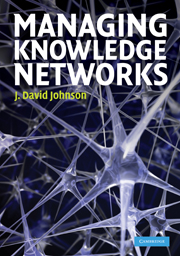Book contents
8 - Bringing in the world outside
Published online by Cambridge University Press: 05 June 2012
Summary
In Chapter 4 we looked at the information fields in which organizations are embedded and discussed some broad conceptualizations of how organizations interact with their information environments. While this book has focused on knowledge within organizations, how knowledge is brought in from the world outside in collaborative relationships is becoming an issue of paramount importance (Gulati 2007). First, the world outside the organization is often the primary source of highly technical, specialized knowledge. Second, environments create imperatives for organizations to learn, to adapt to a changing world. Managers may even trust external information more, given that it is scarce, that it is less subject to scrutiny, and that there are not status or competitive implications for accepting it (Menon and Pfeffer 2003). Third, knowledge sharing is increasingly viewed as a vital mission for organizations that focus on service delivery (Wright and Taylor 2003). Finally, the development of tacit-knowledge communities in many cases is only scalable if individuals outside of the organization (e.g., other members of a profession, suppliers, or customers) can be included in KN.
Here I will first review the role of individual agents, boundary spanners, in bringing in information. Later I turn to more contemporary conceptions that emphasize the role of brokers, who sometimes serve as boundary spanners, but who also have broader roles, especially in the operation of consortia. Increasingly, knowledge and learning are the outcome of complex interrelationships between parties involved in consortia (Powell 1998).
- Type
- Chapter
- Information
- Managing Knowledge Networks , pp. 135 - 166Publisher: Cambridge University PressPrint publication year: 2009



